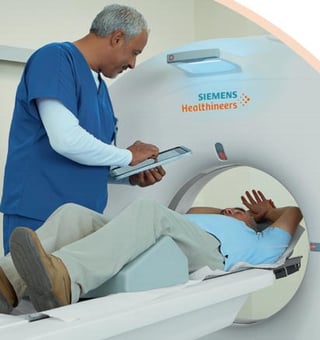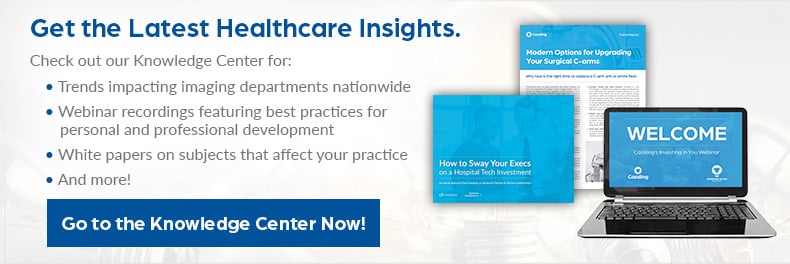 For imaging professionals, conducting a CT scan is an everyday occurrence. But for patients, the very same procedure can be rare enough to cause anxiety, particularly if their future health rests on the results they receive.
For imaging professionals, conducting a CT scan is an everyday occurrence. But for patients, the very same procedure can be rare enough to cause anxiety, particularly if their future health rests on the results they receive.
Historically, the CT experience has put barriers between the practitioner and the patient. Imagine: the patient is brought to an examination room, where they’re introduced to a hulking machine their whole body is about to go through. They’re provided with a strange contrast solution to get the most accurate results. Then, the technologist is required to exit the room while the scan is conducted, leaving the patient alone for the length of the exam.
But does it have to be this way?
Maybe not. With the proliferation of mobile technology within the healthcare world, CT professionals have access to methodologies that enable them to provide an enhanced patient experience. Mobile workflows do away with those portions of computed tomography that create barriers, making patients’ lives (and yours) easier.
Mobile CT workflows free up the CT professional to use a tablet and remote control to operate the machine, as well as process and examine images. Time between steps is reduced, allowing you to spend more time with your patients and conduct tests faster.
Here’s how mobile workflow technology is changing the CT world.
Mobile Keeps You Mobile
The world “mobile” in and of itself provides your first clue that this marks a big change from the traditional way of capturing a diagnostic image.
The nature of a traditional CT scan has essentially mandated that technologists remain separated from patients. You’re capturing an image in a separate room to avoid radiation dosage, plus you’ll spend more valuable time away from the patient just setting up the scan and processing the results. Every moment spent doing those things in a separate area is a moment you’re away from the patient’s side.
Mobile workflow technology truly changes the game. With a tablet and a remote control, you’re able to set up everything you need wherever you like – including by the patient’s side. Carry on a discussion with that person, answer their questions and provide reassurances about what they’ll expect, all while readying the test and facilitating transfer of the results to the appropriate physician.
Automate the Process
With a mobile device as your controls, it takes just a few inputs to ready standard tests. Not only does this increase how much time you can spend with your patients, but it also reduces the time they’ll need to spend waiting and remaining completely still.
This type of automation is perfect for both clinics and patients. For imaging professionals, you’re able to standardize the processes and calibration surrounding the CT scans you conduct on a daily basis. Your routine becomes faster as a result. You’re able to schedule more patients than previously before and those patients have shorter wait times.
Obviously, this is a benefit for patients as well. Less time in the waiting area, less time in the scan and less time to get their results. That latter is made possible thanks to automated post-processing that makes zero-click reconstruction possible. Your studies will be consistent, high-quality, and reproducible because of the capabilities of your mobile platform.
Space Saver
Until now, there’s always been one seemingly insurmountable barrier when it comes to the perfect patient experience: the control room. Obviously, you’re required to be shielded for the duration of the CT scan, and that means an additional room to house the controls and attendant computer equipment.
With mobile workflow technology, the footprint of the controls is virtually nonexistent. Instead, you can operate the CT scan from the safety of a shielded niche located inside the CT area.
This truly is a game-changer for patient interactions. Imagine you have a child who’s nervous about their test. Now consider that child’s relief when they can actually see you from where their test is being conducted. Rather than being cordoned off in a completely different room, you’re just steps away to provide comfort if needed.
Mobile controls give you an unprecedented opportunity to create a positive patient experience, one that’s never before been possible.
The Financial Considerations
It’s the financial benefits that will have CEOs and board members enthusiastic about the prospect of a new hospital tech investment.
First, the overhead costs of a new CT system’s footprint drop significantly when you don’t have to worry about a separate room. Spatial considerations are far easier to manage with a mobile workstation if you use the niche concept. Every square foot is precious in a clinical setting, and with a mobile platform, you free up that square footage for other uses. Or maybe you double up on CT scanners to really enhance how many patients you can take at any given time!
Because you’re speeding up the patient experience through automation and mobility, you have the time to see more patients than you did before. The window of time you need to conduct a scan shrinks, so your daily patient average can go up.
There’s also the power ramifications of a mobile CT workflow. Employing a mobile device to operate a CT means you could save on your facility’s electricity bills as well.
Mobile Goes Global
Mobile technology has infiltrated every aspect of our lives. We carry phones, tablets, even Smartwatches.
It was only a matter of time before mobility came to the CT field as well. With faster workflows, advanced automative functions, improved patient interactions and a smaller footprint that reduces costs, the hospital imaging experience will never be the same.
You finally have the opportunity to transform your imaging practice. Find out what’s possible with mobile workflows.







Comments